Our research revealed several areas to work on, to build and implement a Green IT strategy.
1. Evaluating your carbon footprint
Measuring the impact of digital technology, its activities and its consumption, is an essential prerequisite for any initiative. Without this measurement, it is impossible to determine the company’s digital sustainability approach and demonstrate the positive impact of those actions taken. For an accurate overview, it’s important to take into account the entire value chain including the Scope 3 impact of its suppliers and customers. However, given the lack of transparency between companies and the diverse range of calculation methods, it remains very complicated to have the necessary data to compare oneself to the market.
Devoteam’s vision
Measuring its carbon footprint is the first step for any company keen to identify ways to make positive change. It is the only way to define concrete action plans and estimate the expected short-term benefits. The maturity analysis will allow you to identify longer-term actions needed to continue improving the overall footprint of the entire company.
The two approaches are closely linked and complementary to cover the entire scope of digital responsibility.
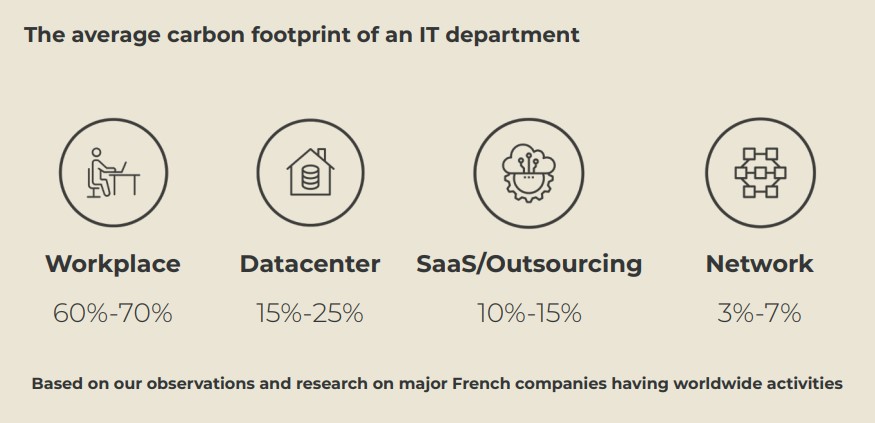
Measurement tools
An IT carbon calculator will provide you with an end-to-end assessment of all your digital emissions sources, integrating the entire life cycle of your IT, as well as all the services you buy from your service providers. With this diagnosis, you can define your business priorities and put in place concrete and targeted measures to achieve them.
Developing your own carbon calculator may be the best solution. Indeed, customisation to each company’s specific needs is essential to ensure data corresponds accurately to your assets and uses. This allows you to have a tool which
is adapted to your activities, which can be improved or adjusted as you evolve or need to integrate more parameters.
This precise feedback can be used as a basis to build impactful action plans and communicate quantified, proven improvements rather than theoretical estimates. As it’s based on concrete results gathered through all stakeholder engagement, this approach will also help maintain individual and collective motivation at all levels.
Summary of the parameters taken into account and the data sources used to build a customised carbon calculator
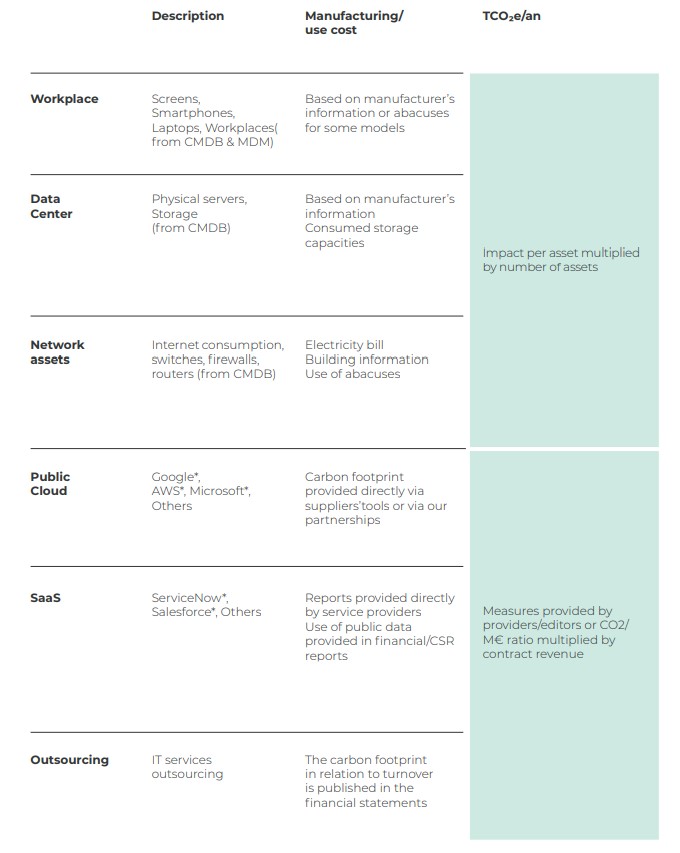
The analysis of business process maturity
The quantitative analysis must then be completed with a maturity assessment to identify where you can improve and launch new projects.
The diagram below summarises the areas around which Devoteam would propose evaluating yourself:
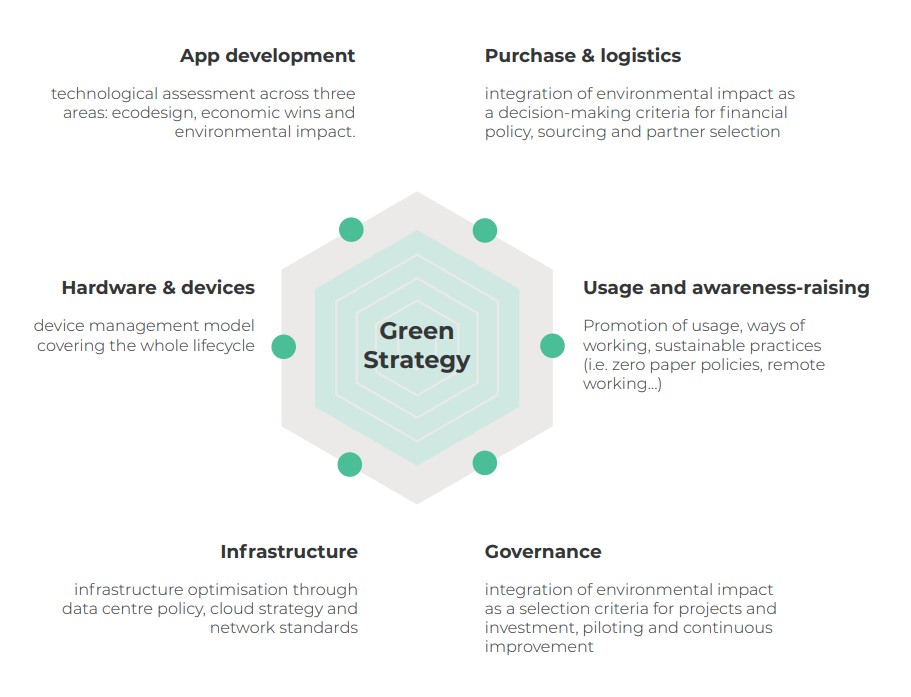
Best practice:
set up an IT carbon footprint
Since early 2020, several of our clients have developed a carbon calculator dedicated to IT. This allows them to go beyond a generalist approach, which might otherwise prevent them being able to identify and monitor the impacts of their IT initiatives.
This approach allows the IT department to contribute to the company’s overall effort, even if its impact is sometimes small, by measuring the digital footprint. It is also the first step in implementing both individual and collective carbon
reduction plans.
It takes 1-2 months to get the first measurements and about 6 months to implement actions to reduce the carbon footprint of assets and infrastructure. Our clients tend to reduce the carbon footprint of their IT department by up to 20% within the first 6 months.
2. Governance
By “governance” we mean all the processes, committees and rules that enable the company to take greater account of environmental issues within its decisions.
Devoteam’s vision
Appropriate governance and a dedicated digital responsibility budget are real accelerators of green transformation for the whole company. Above all, they form the basis for implementing continuous improvement – and this is the challenge of sustainable development. However, we noticed that such a budget allocation is either not implemented or, on the rare occasion it is, tends to be done on too small a scale to have a significant impact.
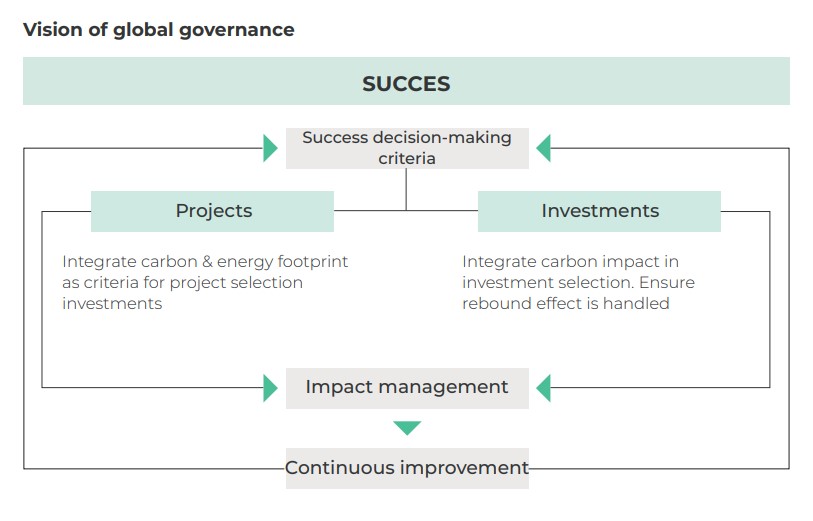
Today, we see that the implementation of governance for digital sustainability is based on three pillars:
Steering committees
Most companies today have a CSR strategy, but few have put in place the right governance to deploy it. Only appropriate governance can guarantee the consistency of Green IT actions towards the wider system and all stakeholders. In fact, it is clear that initiatives around this are still insufficiently coordinated.
We therefore recommend that you include sustainable development issues on the agenda of your existing steering committees, where the relevant stakeholders (IT department, general management, CSR, purchasing, communication, innovation, etc.) already meet. This will prevent sustainability from being perceived as an additional constraint by these players.
Establishing a dialogue on environmental issues between all these parties is key. They each play an important role in the definition and execution of your CSR strategy, as well as other strategic issues. This global, cross-functional and multidisciplinary coordination at the highest level is crucial to maximise the impact of your projects.
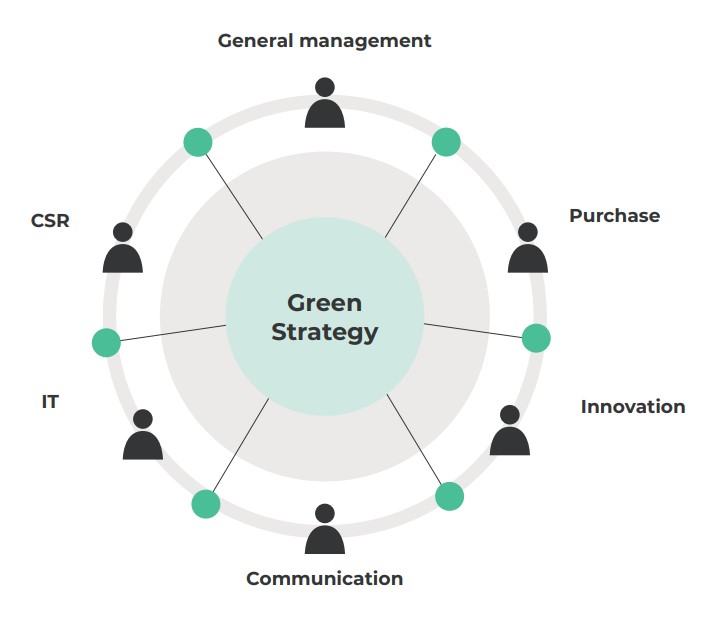
“Green” indicators
There is no catalogue of “off the shelf” indicators, nor a benchmark against which the company can measure itself. As a result, Green IT is still poorly integrated into governance criteria, although some companies are considering a “carbon ROI” to ensure that their actions do not make the situation worse.
To ensure that the various aspects of sustainability are taken into account, you will therefore need to set up your own set of indicators. As digital sobriety often goes hand in hand with cost reductions, certain economic KPIs can be good indicators of the deployment of your Green IT strategy.
The indicators you choose will be reviewed at the previously mentioned governance meetings, and will form part of your decision criteria when making choices and deciding next steps.
A dedicated budget
IT departments still rarely allocate a specific budget to Green IT. Such expenditures are barely part of major transformation programmes, but carried out in an opportunistic way, or to close the budget backlog. This lack of a financial framework does not encourage Green IT to be incorporated in a sustainable manner into the company’s
strategy and can lead to a lack of consistency. In order to tackle the subject of digital sustainability rigorously and over time, a dedicated budget is essential.
Best practice: ROI of digital sobriety
A client operating in the energy sector set up a governance dedicated to Green IT and shared with us some quantitative and qualitative results:
- 10M € saved each year thanks to the reduction of its energy consumption;
- 60 kT of CO2 emissions avoided;
- Complete update of reference systems (applications, CMDB, etc.) to ensure accurate data;
- Asset rationalisation projects to reduce technical debt and accelerate the move to the Cloud, which consumes less energy.
In summary, this client maintains that digital sobriety can lead to profitable projects with minimal investment, and – critically – that this initiative is compatible with wider company rationalisation objectives.
3. Purchases
The purchasing department is a major player in the company’s low carbon approach. It can easily implement measures to significantly reduce the company’s carbon footprint. For example, it can integrate specific indicators into its service
and asset purchase contracts, which are the two most carbon-intensive areas of Scope 3. As Scope 3 alone accounts for between 70% and 80% of IT’s carbon impact, it is a key lever.
Devoteam vision
Scope 3 generally represents the largest part of a company’s digital environmental footprint, meaning the purchasing
department has a major role to play to reduce this.
First, they must understand the possible levers to pull, and then take steps to target the elements with the greatest impact. This can even mean contracting for a maximum carbon footprint, which makes suppliers responsible and encourages them to adopt more virtuous policies.
Purchases of individual services and supplies
Today, most of the IT department activities are outsourced worldwide, generally to reduce the costs and space occupied by people and equipment. Nevertheless, you must take these activities into account when defining your carbon footprint, of which they may even constitute a significant part.
In other words, controlling your emissions means controlling the carbon impact of your third-party services. Purchasing has a role to play here, in particular by requiring service providers to provide the carbon footprint of their services within their contract. Not only does this allow you to make your suppliers more responsible and reward the most virtuous ones, but it also helps provide Green KPIs to manage and monitor changes.
Material procurement and life cycle management
When producing a carbon footprint, it quickly becomes obvious that the workplace, including all employee devices, is the first source of emissions. However, the majority of a device’s carbon footprint lies in its production, while usage only accounts for between 10% to 40% of the total footprint, depending on the country’s energy mix.
The three following actions will help minimise your impact in this area:
- Equipment usage and allocation policy: by implementing a ‘bring your own device’ (BYOD) policy, you will pool the personal and professional equipment of your employees, which will reduce the number of devices, and therefore their manufacture. Without this, you can still use the equipment allocation policy to reduce your footprint, for example by providing laptops rather than desktops and screens.
- Extending the lifespan of assets: Using a tablet or computer for four years instead of two automatically improves its carbon footprint by about 50% while reducing costs. To achieve this, you need to strengthen your support and maintenance policies.
- Equipment sourcing: Implementing a responsible approach is becoming easier with the availability and amount of tools, such as equipment certification and purchasing practices assessment tools. For example, the TCO certification -which meets the sustainability requirements of the ISO 14024 standard – enables you to direct your choices towards more environmentally-friendly assets.

Finally, you can further reduce the environmental impact of your equipment by looking at its end-of-life. Refurbishing it will help preserve resources and avoid CO2 emissions. It will also reduce the amount of waste from electrical and electronic equipment (WEEE), the recycling of which is a legal obligation in some countries, especially in Europe. Reconditioning gives the device a second life at a limited environmental cost, since the footprint of any reconditioning is on average three times smaller than that of producing a new device.
Best practice 1:
Collecting unused devices to give them a second life
One interviewee noted that, following the migration to Windows 10, many devices were no longer used.
They launched a programme to recover these devices and optimise their end-of-life, thereby reducing waste. Some devices were repaired and put back into service, while the others were either recycled or dismantled to reuse their components.
Of the almost 28,000 devices recovered, 75% enjoyed a second life and 15% provided spare parts. The reuse of a fixed PC saves the equivalent of 56 kg of CO2 emissions and 430 litres of water.
Best Practice 2:
Select the most responsible suppliers
Another client, operating in the aeronautical sector, included a Green IT component in its purchasing listing, assessed on eight maturity levels (IT equipment, electronic waste, professional training, ecodesign, etc.). Its IT service providers must now communicate all their responsible digital technology policies and actions. If these are deemed insufficient, the provider has one year to improve or would be removed from the supplier panel.
4. Technologies
The considerable growth in digital technologies has been accompanied by a sharp increase in their carbon footprint. However, there are several ways to limit this impact.
Devoteam vision
Without denying the environmental impact caused by technology, we believe it also offers important new ways to reduce carbon emissions, which is something that should not be overlooked. The cloud is a great tool for effectively reducing a company’s footprint, not only through the virtualisation and streamlining of its equipment, but also via the advanced technologies used by operators to improve the energy efficiency of their data centres.
Innovation in data centers
Strong disparities exist in the carbon footprint of data centres depending on where they are located and their energy mix. In carbon-intensive countries, carbon emission linked to the usage phase exceeds that linked to manufacturing. For example, usage represents 20% of the emissions in France, due to the fact that the energy mix is less carbonated than for other european countries for which it can represent up to 80%. The geographical location of data centres is therefore crucial to reducing their environmental impact.
Data centres accounted for 2% of the world’s electricity consumption in 2013 and are planned to reach 13% by 2030. To mitigate the effects of this increase, start by ensuring that your infrastructure is correctly sized for your uses. Then consider whether it is possible to optimise it and streamline your data to free up physical space and reduce energy costs.
Secondly, you can seek to improve your PUE (Power Usage Efficiency) by limiting the energy needed to run the centre, particularly for the cooling system. Often relying on energy-intensive air-conditioning systems, machine cooling is the main source of energy consumption for data centres. There are various ways to reduce this, starting with better design of the cooling systems. New solutions based on innovative technologies have recently emerged. By optimising the path of the air used to cool the systems (automation of air flows via sensors, use of cold aisles, etc.), it is possible to create cooling systems without air conditioning and reduce the electricity consumption of a conventional data centre by 30% to 50%.
You can also reduce the environmental impact of your data centres by taking advantage of the heat they generate, which can be transported and even amplified. In Switzerland, heat from an IBM data centre is used to warm a local swimming pool. In Denmark, Facebook uses the waste heat from its data centres to heat around 6,900 homes.

Choosing cloud computing
In general, moving to the cloud is also one of the most environmentally-friendly solutions because operators benefit from considerable volume effects and expertise. They are able to maximise the consolidation of virtual machines on each physical server, allowing them to harness the server’s full power. Their excellence in load management and scalability means they can always use their machines to their full capacity, so they don’t waste energy consumption on idle systems.
With their unrivalled investment capacities, the major cloud players are also constantly innovating and improving their practices, which allows them to further reduce energy losses and therefore optimise their PUE.
Finally, most providers (AWS, Azure, GCP) are committed to ensuring that their data centres are mainly powered by electricity from non-carbon energy sources. Some providers, such as Microsoft, even provide a carbon calculator that allows customers to track their own carbon emissions.
All in all, we observe that these different factors make it possible to divide one’s carbon footprint by 20 by choosing Cloud instead of a traditional data centre. However, this requires careful monitoring of Cloud usage, as excessive and
uncontrolled consumption of the services available can increase the IT department’s carbon footprint. We sometimes observe this rebound effect amongst our clients, caused by an increase in data consumption, particularly because of the many innovations available on Cloud platforms.

The contribution of artificial intelligence and data
The rebound effect mentioned above is real: more data use means more data traffic, resulting in more consumption of electricity, infrastructure and therefore CO2. However it also encourages uses that can reduce this impact (the digitalisation of the business allows remote working that reduces travel and therefore its environmental footprint). There are numerous ways for data to protect the environment, and we won’t detail them here. But we are convinced that careful use of digital technology on behalf of the company is possible.
Ecodesign of digital products
The number of Green IT initiatives within IT programming and development activities is increasing. The impact of these activities are wide-ranging and spread over the entire lifecycle of digital products. Ecodesign makes it possible to rethink the digital service and reduce its environmental impact, especially by removing unnecessary lines of code to optimise the size of the programs. Today, on average 64% of functionalities are rarely or never used. By being more efficient they need less computing capacity to operate and therefore consume less energy.
Best Practice: A large-scale switch to the cloud
During the transformation of its infrastructure, a large French industrial group migrated more than 1,000 servers hosted in its data centre to the AWS cloud.
The first step was to adapt the service offering for all non-production environments by turning them off at night and weekends. Over 80% of application managers subscribed to this new service.
The second step involved resizing 50% of the servers to a minimum of half their original size.
Thanks to this transformation and optimisation process, the company was able to reduce the carbon footprint of its infrastructure by around 60%.
5. Usage
Although usage is not the main area for improvement in a Green IT approach, it is a good way of making employees aware of the subject and helping reduce the company’s data flows. Implementing a policy focused on this aspect, combined with appropriate change management, makes it possible to apply good sustainability practices across all levels of the company.
Devoteam vision
Usage is a great value focus area for communication and corporate culture, as it brings employees together to increase awareness while allowing them to express their creativity and understanding. The more ecological awareness and engagement there is at an individual level, the greater the potential bank of new ideas for the company, which will positively impact the brand reputation and image. Employees can also take advantage of digital technology to implement and share new ways of doing things that are beneficial to the environment. Green IT leads to IT boosting a company’s green credentials.
Usage policies
Usage policies make users more individually responsible and, in the long term, allows a company to influence different consumption areas. Be sure to deploy them widely, as the savings will only be significant if the practices are adopted on a large scale.
Firstly, it is possible to control the energy consumption linked to the use of digital technology. For example, many employees subscribe to newsletters they don’t read, send messages with large attachments to more recipients than necessary, or don’t clean their mailboxes. You can easily reduce these bad habits, which have a
significant impact.
The digitalisation of certain carbon-generating operating methods is another interesting area. Given that each employee consumes around 10,000 paper sheet which represents 50 kilos of paper per year, it can be extremely beneficial to introduce a zero paper policy, which is now possible with the maturity of collaborative solutions.
Finally, we should not forget remote working, whose positive impact on the environment became clear during recent lockdowns. At a company level, we’re most focused on two particular aspects: transport and workspaces. By allowing
employees to avoid certain journeys, remote working reduces travel, which is the world’s main emitter of greenhouse gases. As far as workplaces are concerned, since employees can stay at home, they do not need a dedicated office space. Companies can therefore reduce the size of their offices, the amount of equipment provided, as well as the associated heating and air conditioning costs.
However, two points must be stressed here. Firstly, the impact of remote working should not be overestimated, as it was not the main factor behind the 11% reduction in carbon emissions observed in Europe during the first 2020 COVID lockdown. Secondly, if the remote working policy creates two separate workplaces, each with its own equipment, then any carbon savings could be offset by the purchase of additional devices.
Awareness and support
A good way for a company to create positive momentum is to make commitments. One example would be to aim for a certification such as B Corp, which demonstrates that you have met several environmental requirements.
In order to reach all employees and roll out good practices on a large scale, it is also necessary to carry out regular communication and change management actions. To maximise their impact, be careful about the messages you choose and how you disseminate them. Who are you targeting? What are the priorities? How should the messages be formulated? Which channels should be used? How often should you communicate?
Some actions are quite simple to set up, such as making and distributing information videos, or sharing best practice initiatives. They allow you to reach a wide audience and highlight key issues. But it is difficult to measure the impact of
such communications, and therefore their uptake.
Setting up dedicated activities
Dedicated activities are essential to ensure digital sustainability becomes an integral part of the company’s culture. This could include setting up seminars and workshops, such as the digital collage. This tool helps teams understand the
environmental challenges of digital technology through a fun series of presentations, testimonials and expert insights. These sessions, which combine sharing and learning, encourage employees to form opinions on this subject that they can share with their colleagues. In addition to this, formal information meetings reinforce the messages previously shared by the company. For the company, these events are an opportunity to reaffirm its commitments and promote its results.
Best practice: The implementation of a global environmental approach
As part of its dual digital and environmental transformation, a major player in the energy sector is rolling out a programme to change day-to-day employee practices to make them more ecoresponsible.
The programme includes:
- Integrating environmental criteria into the management of the life cycle of assets;
- Distributing a regular dedicated newsletter with educational videos
- Organising an annual day dedicated to digital responsibility;
- Implementing a “digital service with high environmental added value” strategy, which uses digital technology to improve IT practices.
- Defining a communication and awareness plan
